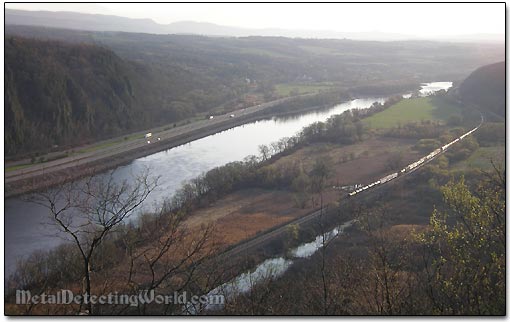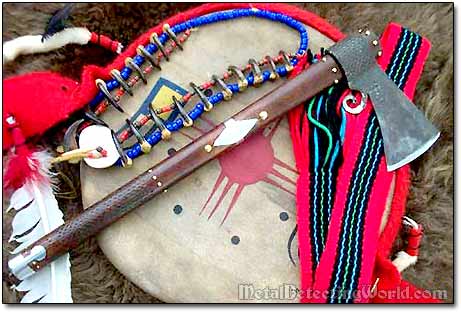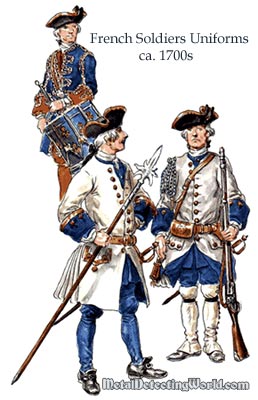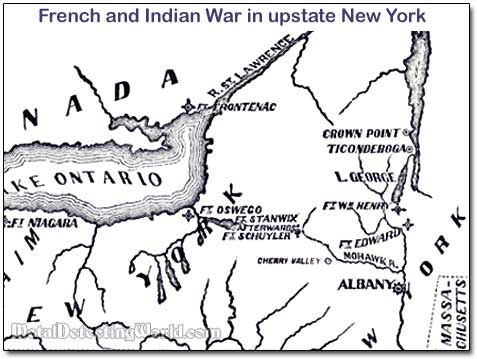Treasure Hunting with Rodney (Story 7), page 36
French and Indian War in Upstate New York: Brief Facts
So we went to the "Little Nose" - a great observation point, located nearby. With 'Big Nose' on the opposite bank of the Mohawk River, it marks a place called 'The Noses'. Without 'The Noses', a natural break in the Appalachian Mountains, the Erie Canal would not be built in the 1800s.
A View of the Mohawk Valley and River Looking West

The Mohawk Valley region of the U.S. state of New York is the area surrounding the Mohawk River, sandwiched between the Adirondack Mountains and Catskill Mountains. The Mohawk Valley is a natural passageway connecting the Atlantic Ocean, by way of the Hudson Valley with the interior of North America.
The region is a suburban and rural area surrounding the industrialized cities of Utica and Rome, along with other smaller commercial centers. The 5,882 square mile (15,234 km²) area is an important agricultural center and encompasses the heavily forested wilderness areas just to the north that are part of New York's Adirondack Park.
In the past, abundant natural resources of the Mohawk Valley provided the Mohawk tribal people with foods and goods, the tribal villages once dotted the river corridor. The original inhabitants of common day Mohawk Valley are traced back as far as 10,000 plus years and included Algonquian people that later relocated from the newly established Fort Orange (Albany), Dutch trading post, as early as 1624. Otherwise, the inhabitants were and remained Mohawks, also called "People of the Flint" in part due to their creation story of a powerful flinted arrow.


In the early 1700s the Dutch, and then German and Scottish arrived and settled the area, joined by Italians following the rapid industrialization of the mid-19th century.
During the 18th Century, the Mohawk Valley was a frontier of great political, military and economic importance. Colonists, such as Phillip Schuyler, Nicholas Herkimer and William Johnson, trading with the Iroquois set the stage for commercial and military competition between European nations, leading to the French and Indian Wars.
At the beginning of the French and Indian conflicts in 1690, 96 Mohawk Indians and 114 Frenchman commanded by Le Moyne de Sainte Helene burned and massacred the Schenectady stockade which was a fur trade center back then. In 1754, the French and Indian War began chiefly because both England and France had claimed the land known as the Ohio River Valley in the hopes of expanding their fur trades.
The French and Indian war (1754-1763), known in Europe as the Seven Years War, known in Canada as the War of the Conquest, was a nine-year conflict between England and France and their Indian allies. The name refers to the two main enemies of the British: the royal French forces and the various American Indian forces allied with them. The war was fought in North America, Europe, and on the high seas.
The first armed conflict took place at present day Pittsburgh, Pennsylvania, and involved future American hero George Washington. Subsequent conflicts took place in present-day New York State, Ontario, Quebec, New Brunswick, and Nova Scotia. Most of the conflicts were waged along the Great Lakes or St. Lawrence River.
During the French and Indian War, the Mohawk Valley was of prime strategic importance: to the British, it provided a corridor to the Great Lakes from which to threaten New France directly, while to the French it provided a corridor to the Hudson Valley and on to the heart of British North America. In addition, many settlements of the Mohawk, Britain's crucial Indian ally at the time of the war, were located in or near the valley.
Scene of Operations of the French and Indian War in New York State
Source: from Harper's Encyclopedia of United States History, Harper and Brothers, 1905.
